Build Time Accelerated Astromovies
How to make such high S/N astromovies is illustrated below
and has been also described
in this page where I explain how to make long Jupiter astromovie of the GRS
in RegiStax6
http://www.astronomie.be/registax/previewbatch1.html
Requirements and tips
- If you don't want to spend I mean it, weeks for processing,
a very fast multicore PC is needed...
(to give an idea, mine is a I7 950 at overclocked at 4GHz, 6TB total including
2x 1TB Raid0 and 3TB USB3 disks for processing, 6GB RAM, ATI Radeon 5770, 2
full HD monitors ...)
- Huge amount of free space on the hard disks (here it took about 150Gb for
Lagarith compressed captures, 640x480 at 60fps and thereafter almost 1.5TB for
the uncompressed AVI
parts and resulting PNG images + quality tests of partial astromovies AVIs !!)
- RegiStax 6.1.0.8, VirtualDub, Irfanview freewares, TotalCommander shareware
and Lagarith codec installed...
- Well polar aligned mount and cleaned camera sensor
Step1 : Get the data
Here I have captured successive AVIs of about 50 000 or 100 000 frames
each with the DMK21AF04.AS at 60fps using IC-Capture and fast and excellent
lagarith loss less codec.
At each manual stop, I did a small AVI of about 1000 frames for instant decompression
in VirtualDub, RegiStax6 processing and sharing the resulting image on the Internet.
Here is a TotalCommander screen copy of a part of the resulting files :
.jpg)
Step2 : Transform the data
Open the first AVI in VirtualDub then append all the other ones in correct
order. See below the total number of frames after 1 append :
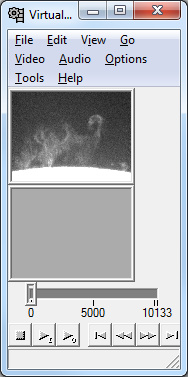
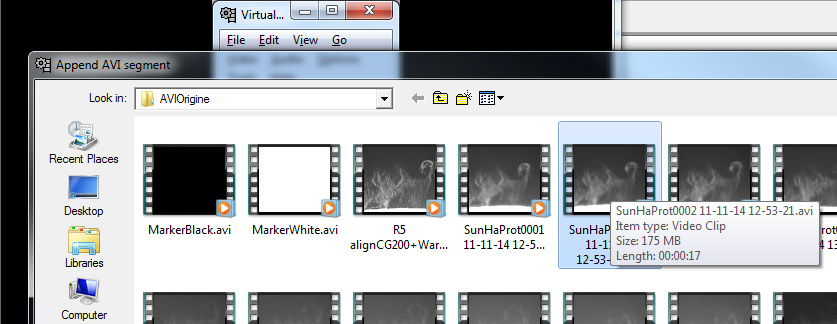
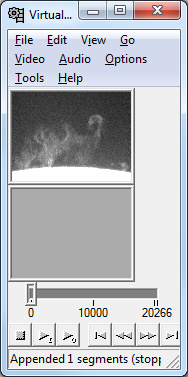
continue appends until all the part are fused in a large AVI.
If possible save the whole AVI in Lagarith - very compact loss less - codec
on disk
in case of problems when saving parts (got VD hanging more than once, indeed
it tries to write a bigger AVI after about 3000 mini AVI written, why I don't
know... ***)
Define a time lapse (1s, 10s, ~17s depending of what you want) and save all
the data as segmented AVIs in uncompressed format or with loss
less Huffyuv v2.1.1 - Multi-Treading Patch v1.0
(tested Ok with RegiStax6 and 4 cores. Note Lagarith and FastCodec not working).
You would create AVIs of 60 , 600 or 1000 frames all less than 1GB.
See below an example of segmented savings of 60 frames each (would give something
of the same kind as the older filenames seen in the Name window.
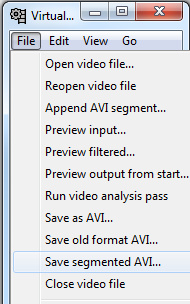

As you can see 1000 frames are about 17s of real time at 60 fps.
I suggest for non Win7 users to batch rename, with TotalCommander, the resulting
AVIs changing the '.' into a '-' otherwise you may have problems with RegiStax6
file savings !
(as VD output names looking like SunHa .........12-53-40.00.avi)
Here is a screen copy of some of the thousands AVIs :

*** If this arrives to you (I guess
because of some interfering other actions) do like in the following example
where I selected a time resolution of 1 sec :
I count the number of AVI created. I multiply by the number of frames of each
AVI. Eg. I get 2773 mini AVIs of 60 frames then already 166380 frames saved
in mini AVIs.
I create a new dir called Sun(1s)-I-2773x60frm and move all the done AVIs there.
I Restart VD, reload the whole AVI and set the same compression (Huffyuv).
I put the frame cursor on 166380, select up to the cursor and hit DEL key. I
now restart saving more segmented AVIs from there (frame 166381) until next
crash when you have to redo the same procedure ...
After that I use TotalCommander to rename all the files
in consecutive order :
 Note : as for the time
precision of 1s (/AVI) I had more than 9999 AVIs I had to use a counter of 5
digits instead of 4 as shown.Also I changed the first filename number to 1 instead
of 0.
Note : as for the time
precision of 1s (/AVI) I had more than 9999 AVIs I had to use a counter of 5
digits instead of 4 as shown.Also I changed the first filename number to 1 instead
of 0.
Of course the "Start at" value is updated
after each batch rename to the value of the previous last file + 1.
When renaming is done I move all the files in the same directory.
Step3 : Process the data
It is time now to open a first segmented AVI and to process it fully with RegiStax6
to set the parameters until you get a nice result in the wavelet page.
When this is done you open the batch procedure. Add filenames (I saw that it
is limited to about 3000, probably this depends on the length of the filename
... to be checked for next Registax update).
Save and insert the macro commands which will align, register, stack, sharpen,
apply histogram and save the (just registered) stack and also the wavelet results
in PNG.
The stack PNGs are important as you may have to rework some of them individually
to correct eg. luminosity variations, histogram ...
Here is a screen copy showing RegiStax6 working unattended on a large serie
of 1000 frame AVIs :
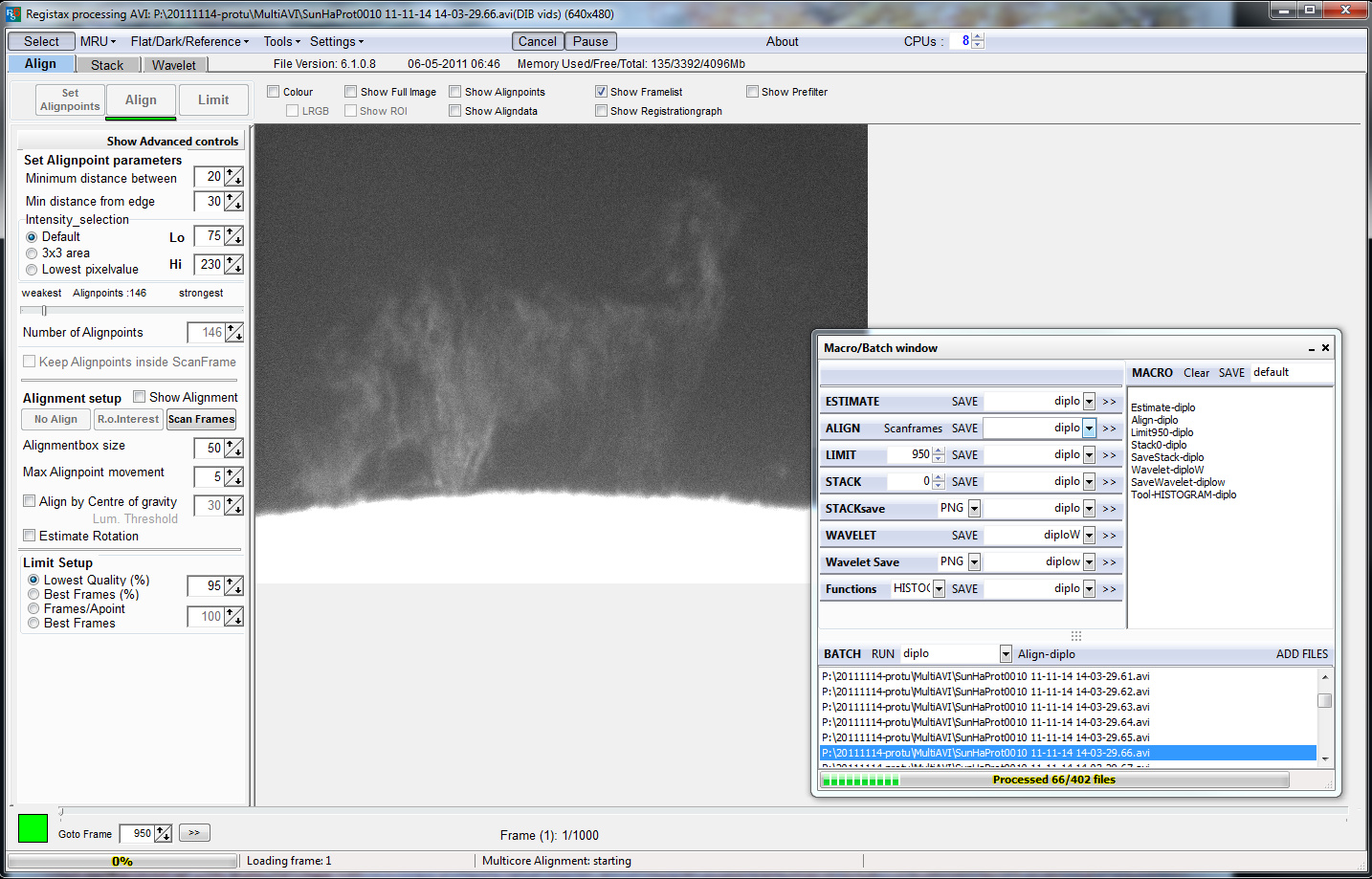
Note : if Registax6 hangs on a some AVIs restart the PC. But anyhow don't forget
to take notes of the align & wavelet parameters used !
When done close and restart RegiStax, add some more files and
redo the batch process...
See RegiStax6 doing batch processing & savings ...
your choice of .wmv
or .mov
Step4 : Final work
When this is done you have now thousands of processed PNGs with and without
final wavelet processing. Open the wavelet ones with RegiStax5
better adapted for this IMHO (Note : testing this actually**).
Use a high blur filter to eliminate the small movements and a large selection
256x256. Align them on one stable foot of the prominence and save in uncompressed
AVI format (that's on stack page).
Redo it a couple of times from the resulting AVIs if needed, lowering the blur
value, until correct stability (remember, no loss of quality as uncompressed).
When satisfied, open the resulting AVI in VD and eliminate the bad frames with
DEL key. You can adjust levels too (Video / filters / add / Levels).
Save the modified AVI in uncompressed or Huffyuv format as backup. When this
is done, crop the moving borders (Video / filters / add / Null transform / cropping)
and save the AVI in Divx or Xvid format. Also (only with uncompressed settings
you can do it) export into GIF (a resize will help keeping the size correct
!) which can be seen directly with navigators.
Finally save in uncompressed format as a backup and you may want to convert
into .wmv (for Windows users) or .mov (Mac users).
** Unhappily both RegiStax5 and RegiStax6
are unable to cope with very large AVIs of more than a 10 000 frames or work
is extremely slow then almost impossible. Then I have to cut into 1000 frm AVIs
with Virtualdub but there after the control of the alignment in between thoses
aligned parts is problematic ... Also in each 1000 frm AVi, aligning on a permanently
changing prominence is very very difficult. The best I have obtained is using
RegiStax5 with 256 pixels registration squares, then saving UNC then redoing
with 128 squares then saving UNC then redoing with 64 pixels squares) and this
based on top of the solar disk and horizontally centered on the brighter part
of the major foot of the prominence. I also tried pre-gradient filters with
some success. The AVIs have to be cropped after that with VirtualDub in order
to get the main foot of the prominence at the same XY location at the end of
first AVI and begining of second AVI. As you can imagine this is far from simple
and takes many days of work !! Will do a trial with less than 10 000 frames
to see...
Of course this is the main road for processing ... you will have to do things
depending of the raw data you have ! For example you may have to rework with
RegiStax6 some stacked PNG to correct for different luminosity or contrast ...
Some of them may not be good (very dark because of clouds passing by or else
...). Open with VirtualDub and do the necessary cleaning !
.jpg)






 Note : as for the time
precision of 1s (/AVI) I had more than 9999 AVIs I had to use a counter of 5
digits instead of 4 as shown.Also I changed the first filename number to 1 instead
of 0.
Note : as for the time
precision of 1s (/AVI) I had more than 9999 AVIs I had to use a counter of 5
digits instead of 4 as shown.Also I changed the first filename number to 1 instead
of 0.